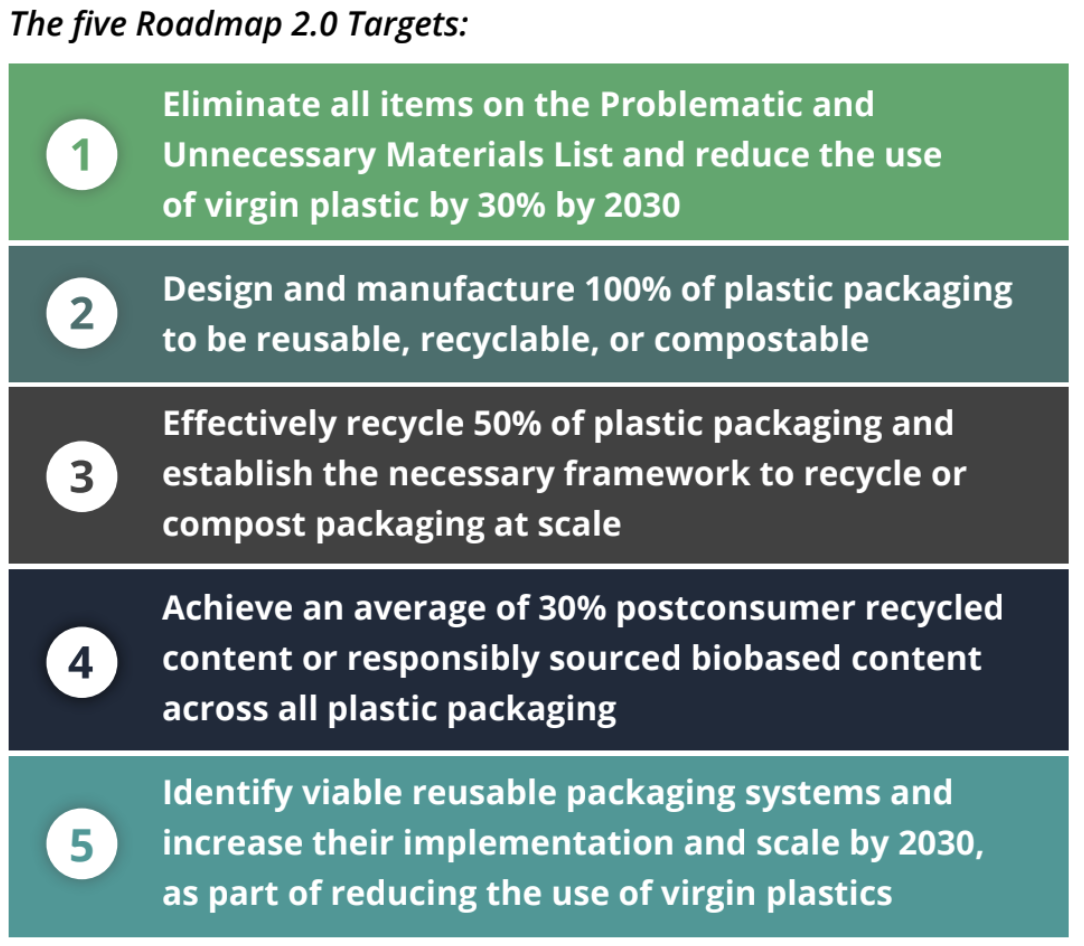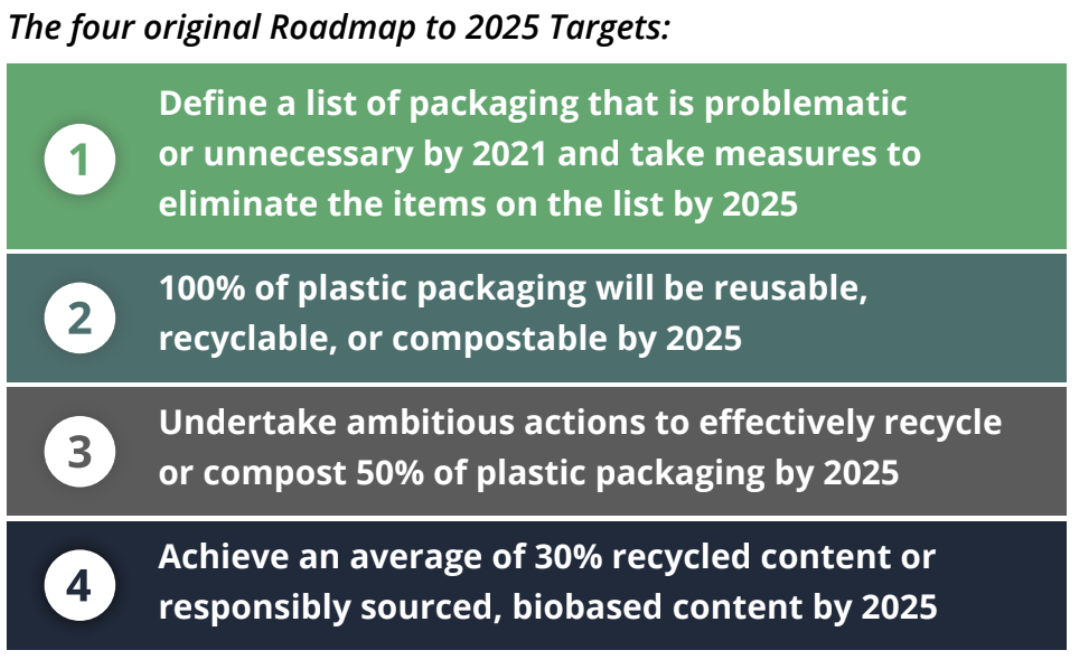The U.S. Plastics Pact representing 80 companies — including Coca-Cola, Nestlé and Danone — has pushed back deadlines to drastically reduce their use of plastic, from 2025 to 2030.
The five-year slip reflects how corporations are often failing to meet the audacious goals climate goals they set less than a decade ago. At the same time, plastic production has escalated. In 2022, manufacturers churned out 400.3 million metric tons of plastics, up by 1.6 percent from 2021, according to Statista.
The following targets for plastic packaging are no longer set for 2025, according to the pact:
- Eliminating problematic materials, such as tableware and PFAS chemicals.
- Baking in reusability, recyclability or compostability to all packaging.
- Reaching a 50 percent plastic recycling rate.
- Integrating recycled or responsibly sourced bio-based materials into 30 percent of all packaging.
“Yes, they were very ambitious,” said Emily Tipaldo, executive director of the U.S. Plastics Pact. “You have to set a marker. And that’s what the targets did in 2020. This put a marker out there very publicly to say, ‘This is what we’re aiming for, especially in the US when we don’t have a federal government that’s really acting on this.’”
Not all pact members expressed a rosy outlook.
“I am frustrated that the burden of creating infrastructure is continually shifted,” said Lauren Click, executive director of Let’s Go Compost, a nonprofit pact member. Her Scottsdale, Arizona, organization advocates for compostable packaging in school lunchrooms. “Packagers refuse to fund it, municipalities lack the funds, and the public is already overwhelmed by recycling, let alone compostable plastics.”
Missing federal policy
Founded in 2020, the U.S. Plastics Pact was first launched in the U.S. by the Ellen MacArthur Foundation. There are now 12 pacts globally.
Roadmap 2.0 by default acts as a national strategy for the plastics packaging value chain.
At the time, the U.S. was — and remains — the largest market without laws mandating extended producer responsibility (EPR), which require companies to take care of the waste their packaging creates, Tipaldo noted. So members of the US Plastics Pact — representing about a third of the nation’s plastic packaging market — made their commitments independently.
Over time, that encouraged bills to move forward in several U.S. states.
“Because they’ve been able to do that on a voluntary basis over the last few years, that’s what has cultivated the support for extended producer responsibility for packaging to deposit return systems and recycled content mandates,” Tipaldo said.
“One of the unseen, in-the-background benefits, I would argue, is the groundswell of support for policy. … And again, it may be incremental, but we need to be going in that direction.

![]()
Sticking points
The blown deadline does not come as a surprise. It was clear in October 2023 that most companies were not on course to hit the 2025 target.
The main sticking points were the lack of national standards imposed by federal regulation — which would have forced all companies to change — and the low prices of abundant virgin plastic, Tipaldo said.
The pact, based in Walpole, New Hampshire, now requires members to submit annual progress reports on how they are removing virgin plastic from their operations. That project is called “Roadmap 2.0.”
“Roadmap 2.0 by default acts as a national strategy for the plastics packaging value chain, in terms of how we’re looking across the value chain, to build a circular economy for plastics packaging,” Tipaldo said.
How the roadmap has changed
Here’s how the pact’s five new targets differ from the original four from 2020:
1. New target: By 2030, eliminate 11 “problematic and unnecessary materials,” such as plastic cutlery and straws.
- Original target: Develop the list and eliminate the materials on it by 2025.
- Progress: Members reduced the presence of those items from 14 percent to 8 percent of packaging.
2. New target: All plastic packaging to be capable of being reused, recycled or composted. For packaging makers and users, the deadline is 2030.
- Original target: 2025 deadline.
- Progress: Members grew the amount of reused, recycled or compostable materials from 37 percent to 47.7 percent of all packaging.
3. New target: Recycle half of all plastic packaging. Establish recycling or composting at scale.
- Original target: Recycle or compost half of plastic packaging by 2025.
- Progress: Data not available.
4. New target: Reach an average of 30 percent recycled or bio-based content for all plastic packaging.
- Original target: 2025 deadline.
- Progress: Increased post-consumer recycled and biobased content in packaging from 7 percent to 9.4 percent.
5. New target: Identify, increase implementation and scale viable reuse systems by 2030. Reuse is a new major focus.
The second, third and fourth targets no longer have an overarching target date. However, most of the “building block” steps leading to them have delivery dates between now and 2030.

Coca-Cola: ‘We know more must be done’
US Plastics Pact members Unilever, Mars, Clorox, Conagra, Kraft Heinz, L’Oréal and Kimberly-Clark did not respond to requests for comments on their group’s shifting targets.
However, Coca-Cola — the biggest generator of plastic pollution, according to an April study — said it is 90 percent of the way toward its 2025 goal of making all its packaging recyclable. The company also wants to cut its plastic usage by the equivalent of 800 million plastic bottles next year.
I am frustrated that the burden of creating infrastructure is continually shifted.
By 2030, the beverage giant wants half its packaging to be from recycled material; to recycle a bottle or can for each one sold; and to make reusable or returnable packaging 25 percent of the total.
“We know more must be done, and we can’t achieve our goals alone,” a Coke spokesperson told GreenBiz.
A spokesperson for Plastics Pact member Keurig Dr Pepper told GreenBiz it remained optimistic about reaching its 2025 goals. By the end of 2022, the company was 92 percent of the way toward 100 percent recyclable or compostable packaging for 2025, according to its last sustainability report. Twenty-four percent of its post-consumer content was recycled, against a goal of 30 percent.
Conspicuous by their absence: PepsiCo and Altria
Of the five biggest generators of plastic — who create 24 percent of the pollution — two are not members of the pact. They are PepsiCo and Altria. Tipaldo is hoping that the new, more lenient deadline might tempt more brands to join.
“I’m really curious to see if we might be able to bring some additional companies in, now that we’re looking beyond 2025,” Tipaldo said.
- SEO Powered Content & PR Distribution. Get Amplified Today.
- PlatoData.Network Vertical Generative Ai. Empower Yourself. Access Here.
- PlatoAiStream. Web3 Intelligence. Knowledge Amplified. Access Here.
- PlatoESG. Carbon, CleanTech, Energy, Environment, Solar, Waste Management. Access Here.
- PlatoHealth. Biotech and Clinical Trials Intelligence. Access Here.
- Source: https://www.greenbiz.com/article/pact-including-coca-cola-nestle-moves-2025-plastic-reduction-goals-2030



